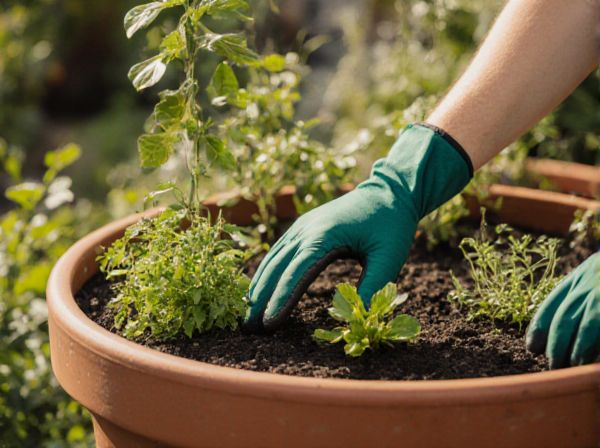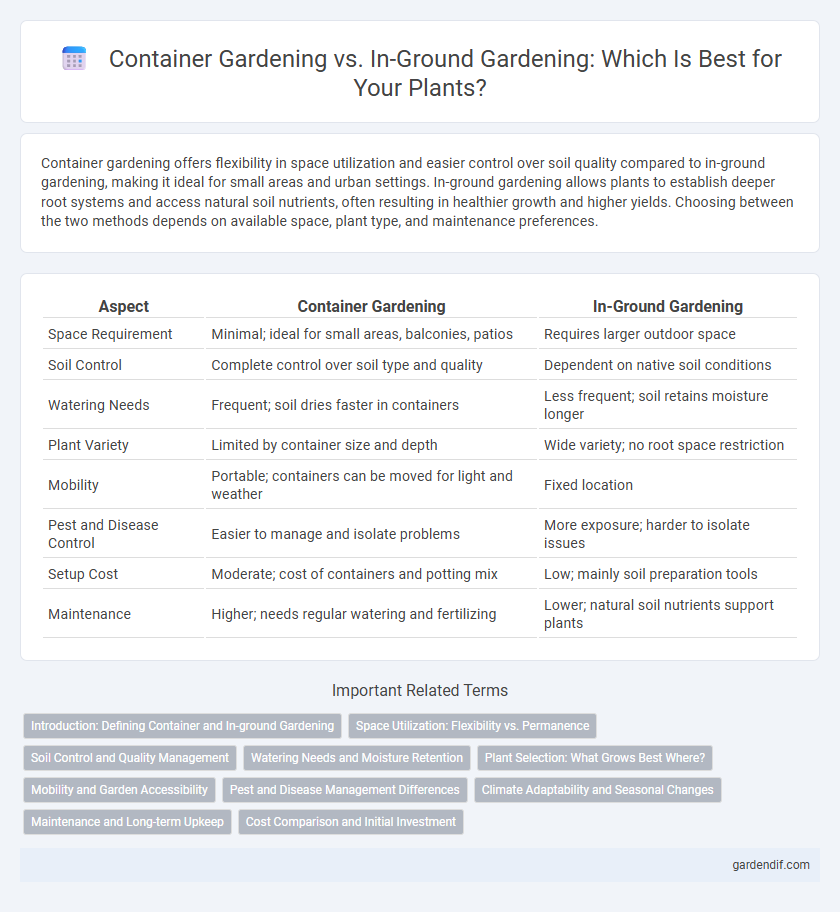
Container gardening vs In-ground gardening Illustration
Container gardening offers flexibility in space utilization and easier control over soil quality compared to in-ground gardening, making it ideal for small areas and urban settings. In-ground gardening allows plants to establish deeper root systems and access natural soil nutrients, often resulting in healthier growth and higher yields. Choosing between the two methods depends on available space, plant type, and maintenance preferences.
Table of Comparison
| Aspect | Container Gardening | In-Ground Gardening |
|---|---|---|
| Space Requirement | Minimal; ideal for small areas, balconies, patios | Requires larger outdoor space |
| Soil Control | Complete control over soil type and quality | Dependent on native soil conditions |
| Watering Needs | Frequent; soil dries faster in containers | Less frequent; soil retains moisture longer |
| Plant Variety | Limited by container size and depth | Wide variety; no root space restriction |
| Mobility | Portable; containers can be moved for light and weather | Fixed location |
| Pest and Disease Control | Easier to manage and isolate problems | More exposure; harder to isolate issues |
| Setup Cost | Moderate; cost of containers and potting mix | Low; mainly soil preparation tools |
| Maintenance | Higher; needs regular watering and fertilizing | Lower; natural soil nutrients support plants |
Introduction: Defining Container and In-ground Gardening
Container gardening involves growing plants in pots, containers, or other confined spaces, ideal for limited or non-traditional gardening areas. In-ground gardening refers to planting directly in the soil, leveraging natural ground conditions for root growth and water absorption. Both methods require distinct soil management and watering techniques tailored to their environments.
Space Utilization: Flexibility vs. Permanence
Container gardening offers unparalleled flexibility in space utilization, allowing gardeners to easily move plants to optimize sunlight, protect from weather, or redesign layouts. In-ground gardening, while more permanent, maximizes space for root expansion and supports larger plants with deeper soil access. This permanence can limit adaptability but provides a stable environment for long-term growth.
Soil Control and Quality Management
Container gardening provides superior soil control by allowing precise selection and management of soil composition, pH levels, and nutrient content tailored to specific plants. In-ground gardening faces challenges such as inconsistent soil quality, potential contamination, and difficulty in amending soil properties effectively. Enhanced quality management in container gardening results in optimized root health, improved drainage, and reduced risk of soil-borne diseases compared to traditional in-ground methods.
Watering Needs and Moisture Retention
Container gardening requires more frequent watering due to limited soil volume and faster drying, while in-ground gardening benefits from deeper soil that retains moisture longer. Containers with good drainage and materials like terra cotta or plastic influence evaporation rates and water retention. Using moisture-retentive potting mixes and mulching in both methods improves water conservation and plant health.
Plant Selection: What Grows Best Where?
Succulents, herbs, and small vegetables such as cherry tomatoes thrive in container gardening due to controlled soil conditions and portability, allowing for optimal drainage and sunlight exposure. In-ground gardening favors larger, deep-rooted plants like corn, squash, and root vegetables, which benefit from the extensive nutrient availability and natural ecosystem interactions. Understanding plant root depth and space requirements is crucial for maximizing growth potential in each gardening method.
Mobility and Garden Accessibility
Container gardening offers superior mobility, allowing plants to be easily relocated to optimize sunlight exposure or protect them from adverse weather conditions. In contrast, in-ground gardening remains fixed, limiting flexibility but often providing more extensive root growth and soil access. Container setups enhance garden accessibility, especially for individuals with limited mobility, by reducing the need for bending and facilitating maintenance at waist height.
Pest and Disease Management Differences
Container gardening offers greater control over soil composition and moisture levels, significantly reducing exposure to soil-borne pests and diseases compared to in-ground gardening. The limited root space and contained environment in containers make it easier to isolate and treat infestations without affecting surrounding plants. In-ground gardening, however, is more susceptible to pervasive pests like nematodes and fungal pathogens that persist in the soil and require broader management strategies such as crop rotation and soil amendments.
Climate Adaptability and Seasonal Changes
Container gardening offers superior climate adaptability by allowing precise control over soil quality, moisture levels, and placement, making it ideal for regions with extreme or unpredictable weather. In-ground gardening depends heavily on local soil conditions and seasonal changes, often limiting the types of plants that can thrive throughout the year. Containers can be easily moved to optimize sunlight exposure or protected from frost, extending growing seasons and improving plant survival rates in variable climates.
Maintenance and Long-term Upkeep
Container gardening requires more frequent watering and fertilizing due to limited soil volume, but it offers easier pest control and soil management compared to in-ground gardening. In-ground gardening demands less frequent irrigation and often relies on natural soil fertility, yet it faces higher risks of soil-borne diseases and weed invasion that require ongoing attention. Long-term upkeep in containers involves regular repotting and soil renewal, whereas in-ground beds benefit from natural soil ecosystem processes but need periodic tilling and amendment to maintain productivity.
Cost Comparison and Initial Investment
Container gardening typically requires a higher initial investment due to the cost of pots, containers, and specialized soil mixes, whereas in-ground gardening benefits from utilizing existing soil with minimal upfront expenses. Ongoing costs for container gardening include purchasing fertilizers and frequent watering systems to maintain plant health, contrasting with the lower maintenance costs of in-ground gardens, which rely more on natural soil nutrients and rainfall. Overall, container gardening demands a larger budget initially but offers flexibility in plant placement and mobility not found in traditional in-ground setups.
Container gardening vs In-ground gardening Infographic

 gardendif.com
gardendif.com